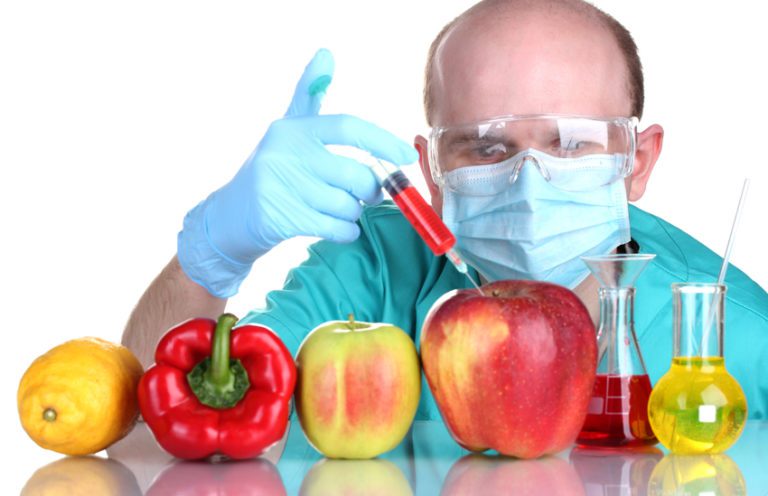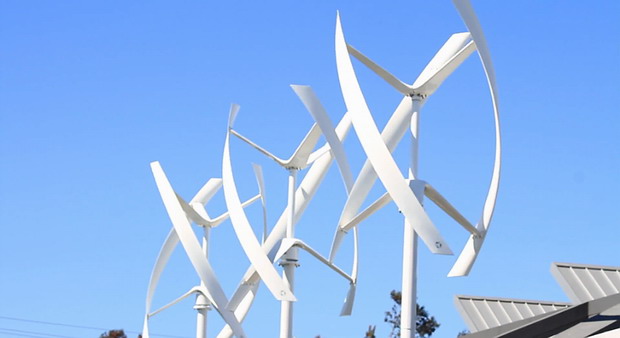So let us break down some of the major areas where the food chain is currently
vulnerable and examine the threats to our resources that are behind this prediction.
I will keep these sections as concise as possible and concentrate on the specific
issues (How we provide solutions will follow later in this book).
The Impacts of Climate Change
The key impacts of climate change that make our crops vulnerable are the shifts in
hydrologic patterns (the disbursement of atmospheric moisture) and the effects of
altered temperature ranges. This can have a negative impact on agriculture, bio-
diversity, and eco-systems in general. Our agricultural farm belts where we are
able to raise crops worldwide exist only in areas where there is a suitable balance
between land/water resources and climate. Flooding, droughts, longer warm
seasons or unseasonably cold temperatures throw this balance out of whack. When
these changes occur, plants in those eco-systems become weak due to stress and
either die, fail to blossom, or become prone to insect infestation and plant viruses.
We can all feel and see this impact as food prices trend higher as a result of crops
failing with greater consistency resulting in supply chains being squeezed.
One of the clear impacts with a climate “shift” will be its immediate impact on our
food chain. Global agriculture infrastructure is located in regions suitable for those
crops where those specific plants get adequate water and consistent seasonal
temperatures. All agriculture depends on adequate rain fall, or access to available
water supplies from rivers, lakes, and aquifers which make it possible for them to
flourish. Our distribution systems of dams, canals, and irrigation networks are all
designed to work within those parameters and with those stationary local
resources. Additionally, each of the local species of plant we raise for food has
adjusted to a consistent length of a season and a temperature range that deviates
only slightly from year to year. A dramatic shift in climate, rain patterns, and water
distribution will leave much of our supportive food production infrastructure in the
wrong place and most of those crops in inhospitable conditions in which they will
not do well. If all this happens abruptly we will not have the time to reorganize and
bring back global food production to pre-shift levels. As such, we will assuredly
lose a large portion of our population to the ensuing famine.
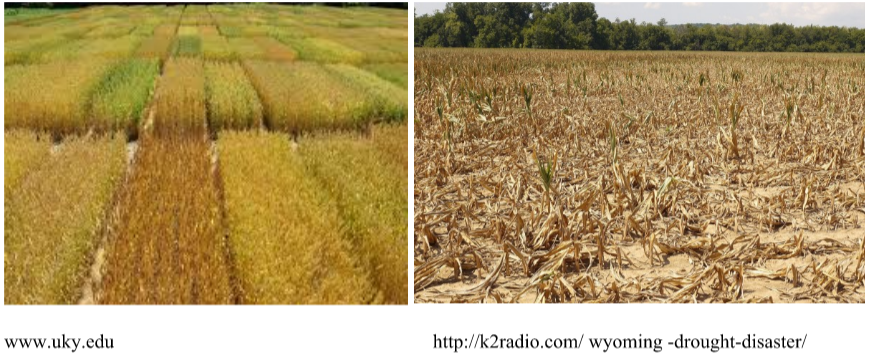

The fact that the weather is changing is undeniable. Since 2009 there have been
100 year droughts in Australia, China, India, East and West Africa, and devastating
dry periods in Russia, South America, the southeastern U.S., and throughout
California. This is not “normal” as some people would argue. The scientific data
now available through recent studies of ice cores and deep sea ocean sediments,
have increased our understanding of climate patterns exponentially to where we
have a clear idea of what is “normal”. Recent record warm and cold temperatures,
floods in areas that rarely if ever flood, powerful storms and unusual seasonal
weather systems have filled news headlines increasingly over the last few years.
The Loss of pollinators


Bees are responsible for pollinating 90% of fruit and vegetable growth world-wide.
CCD or Colony Collapse Disorder is rampant throughout our global agricultural
network and soon threatens to eliminate perhaps the single most important species
on our planet in regards to supporting human food production. A look at just some
of the crops dependent on Bees for their growth cycle include;
Nuts, berries, broccoli, cauliflower, brussels sprouts, cabbage, beans,
turnips, peas, peppers, papayas, apples, melons, tangerines, coconuts, okra,
kiwi, onions, coffee, herbs, spices, cucumbers, squash, lemons, limes,
oranges, carrots, buckwheat, figs, fennel, mangoes, alfalfa, avocados,
apricots, cherries, plums, peaches , nectarines, guavas, pears, eggplants,
cocoa, tomatoes, and grapes…
…to name a few.
Try to imagine for a minute what your life and diet would be like without just
some of those options. The US Department of Agriculture showed a 29 % drop in
beehives in 2009, following a 36 % decline in 2008 after a 32 % fall in 2007.
Losses globally were comparable. In 2010, the USDA reported that data on overall
honey bee losses for 2010 indicated an estimated 34% loss. [37] After bee populations
dropped 23% in the winter of 2013, the Environmental Protection Agency and
Department of Agriculture formed a task force to address the issue. [38] Below are
recently updated figures from the US Department of Agriculture published in a
May 2015 article in the Wall Street Journal.
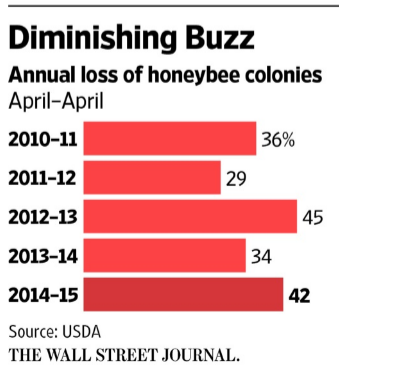

collapse. He was a pretty smart guy so perhaps we should start paying attention?
The Loss of Farm Lands
As populations continue to grow our need for living space and additional industrial
output to service that increased consumption is putting increased pressure on our
land reserves. More and more land that was historically used for farming is being
converted to more profitable use such as housing or commercial development. In
turn this has forced our remaining farms to try and produce more to make up for
that reduced production space as demand rises. Additionally the movement to start
utilizing former food producing lands for biofuel production such as ethanol and
organic fuel oil is cutting into our traditional agricultural lands on a massive scale
as nations try to augment their fuel needs with cheaper home-grown alternatives.
UN special rapporteur Olivier de Schutter said in an October 2010 Rome meeting
for world food security that a combination of environmental degradation,
urbanization and large-scale land acquisitions by investors for biofuels is
squeezing land suitable for agriculture. “Worldwide, 5m to 10m hectares of
agricultural land are being lost annually due to severe degradation and another
19.5m are lost for industrial uses and urbanization,” he said in his report.
Soil Nutrient and Topsoil loss
If reducing our production space for food were not enough of a threat with an
exploding global population, plant nutritional content is also becoming an issue as
soils around the world are lost or depleted of critical components by overuse and
mismanagement. Years of poor farming and careless irrigation practices have
contributed greatly to a systematic stripping of key elements from our soils that are
needed for healthy crops. This has also created an unnatural reliance on fertilizers
making once prime farm lands now completely dependent on massive amounts of
industrial additives in order to grow our produce and grains.
Additionally, in order to flourish in these poorer growing conditions, native crops
have been replaced by genetically modified varieties that are better able to deal
with these conditions. The result is less nutritional crops that are comprised more
and more out of nutritionally poor cellulose (plant cell walls). It is a real issue as
the vitamin and nutritional value of the produce we consume and need as part of a
healthy diet is reduced.
Then there is the loss of topsoil. It is clear that we are eroding soils at a rate much
faster than they can regenerate. Cropland in the U.S. is being eroded at least ten
times faster than the time it takes for lost soil to be replaced according to the
National Academy of Sciences. The United Nations has been warning of soil
degradation for decades. This is a major concern in the third world where soil loss
has contributed to the rapidly increasing number of malnourished people. Topsoil
grows back at the rate of an inch or two over hundreds of years and can therefore
not be taken for granted. Like all our resources it is finite.
Furthermore pesticides and weed killers have also played havoc with our farm
lands. In an effort to eliminate the unwanted weeds and crop destroying pests that
have always threatened a farmers crops, we have introduced chemicals into that
system that were created to eliminate those twin nuisances. Unfortunately, while
they may kill the weeds and insects they were meant to defend against, those same
chemicals destroy the bacteria in healthy soil that breaks down the raw elements
which provide the nutrition for the plants. This renders the soil incapable of
producing crops without the addition of fertilizer.
Finally poor farming practices have also impacted soils. This is an issue
particularly in developing nations where growing populations are forced to try and
make marginal drylands agriculturally productive. Overuse makes these lands
increasingly unproductive as the sparse organic components native to the soil are
removed by the crops. Additionally irrigation tends to concentrate salts in that
same soil rendering them infertile as time goes by.
Limited Phosphorus Reserves
That reliance on fertilizer is ultimately one of our greatest causes for concern.
Phosphorus is one of the three main elements that make up fertilizer and there is no
substitute for it. Phosphorus is essential for cell wall, root, and flower development
in plants. Without this crucial and irreplaceable mineral there would be no
“fertilizer” and our current global agricultural model as we know it today would
collapse. The loss of phosphorus as a feedstock would lead to more than 2/3 of our
population (4-5 billion people) starving to death from the resulting scarcity of food.
Phosphorus cannot be synthesized and without it we will soon run out of sufficient
food to feed our growing population. It’s that simple.
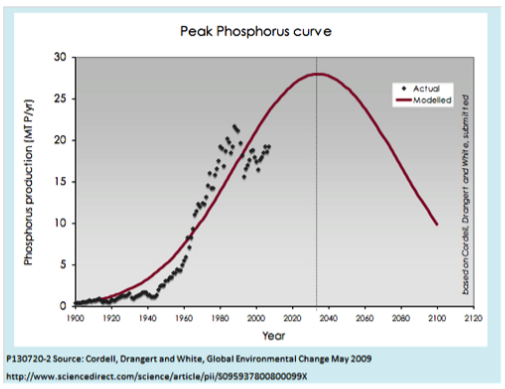

Although opinions differ on the subject (similar to the argument on climate
change) most experts without a financial stake in the issue believe we have perhaps
just 50 to 70 years of easily mineable reserves left. Some believe that number to be
much closer to 40 years. Peak production levels are now quickly approaching and
once we start our decline the impacts of reduced availability and increased cost
will start a cascading collapse of agricultural stocks in poorer countries unable to
afford fertilizer. At that point our global population will start to starve in mass. The
U.S is believed to have less than 25 years of these crucial reserves left.
Aquifer and Groundwater Depletion
Most areas of the world depend on aquifers, healthy river systems, and inland
water sources for their agricultural needs. Agriculture is the single largest user of
the world’s freshwater resources consuming 70% of those reserves. [39 ] It takes
around 2,000 – 3,000 litres of water to produce enough food to satisfy one person’s
daily dietary need. [40] When you consider that the average person requires just two
to five litres a day for drinking purposes alone, this is an extraordinary number.
Water dependence (the need for additional fresh water supplies) is growing
annually and a critical challenge for farmers. This is becoming even more of an
issue as rain patterns begin to shift with our changing climate making a once
dependable resource a thing of the past. Additionally farmers in many areas of the
world are now over-using these diminishing finite resources in an attempt to grow
their crops, or in many cases increase their output to keep up with accelerating
demand.
Northern China is losing farm land at the rate of 2100 square kilometers per year
due to a regional system collapse of their aquifers. The same is true for India as
both countries are burdened by explosive demand for more fresh water and
agricultural output as a consequence of huge, growing populations. River systems
have been so overburdened by the irrigation needs of farmers that bodies of water
such as the Aral Sea which was once the forth largest fresh water lake on the planet
have all but disappeared.
In the U.S., the Ogallala aquifer which runs from the Dakotas to Texas (the major
water resource for Midwest U.S. farming) has seen water levels drop over 150 feet
in some areas threatening farm production. Current water use is at 130-160% of the
recharge rate. In addition, the Colorado River which is the main water resource for
the U.S. Southwest and Southern California is being de-watered at a rate of 1% per
year (USGS Fact Sheet). In California’s fertile central valley snow pack depletion
in the Sierra Mountains threatens to turn arguably the most important farmland in
the world into a desert by mid-century.
Depending on who you ask we could looking at a global agricultural model where
as much as 75% of our current production will be dependent on water sources that
will no longer exist by 2075. This reduction of resources will happen in stages with
each phase ushering in a new era of untold suffering and deprivation to the
populations directly impacted. Water security and planning for continued water
scarcity must be a central goal of governments globally or this crisis will have a
devastating impact on human society as we now know it.
Agricultural Bio-diversity Reduction
The majority of the fruits, vegetables, and grains that our society consumes today
are the result and end product of scientific modification. GMO’s (Genetically
Modified Organisms) have replaced the huge diversity of ancestral stocks that used
to feed our masses.
In an effort to provide a more profitable, dependable, and uniform product,
commercially-grown fruits and vegetables have been manipulated by biologists to
produce a more consistent look and flavor with higher yields. Very often these
varieties are less nutritious sacrificing vitamins and mineral development so that
the plant builds cellulose (Cell walls) faster and mature more rapidly. Additionally,
a small number of “super grains” have been created that can adapt more easily to
varied growing conditions and harsher climates. Although this has been quite
successful and of value for many aspects of our agricultural production, it has also
made our farm production vulnerable to targeted viruses that can potentially wipe
out singular varieties of a species. By purposely reducing the number of strains we
cultivate in an effort to homogenize our agricultural products, we have left the door
open for a potentially catastrophic collapse of those limited crops.
Now when a virus breaks out in a particular agricultural food source it has the
potential for wiping out that entire strain worldwide. This is evident in the wheat
blight known as Ug99, a new form of stem rust that has spread out from central
Africa that now threatens to destroy the world’s entire wheat supply. Loss of this
food stock would create a global crisis and result in potentially tens of millions of
people dying from starvation as a core food source disappears. Another crop, the
Cavendish banana is being wiped out by the tropical race 4 virus. [136 ] This will
eventually eliminate the second strain of mass marketed bananas to fall victim to a
worldwide sickness in the last two decades.
Biodiversity is the natural defense that protects our food supply. To limit the
variety of crops we raise when it is both reduces their nutritional content and
makes those crops more vulnerable to a catastrophic collapse is nothing short of
madness.
Dependence on Fossil Fuels for Food Production and Transportation
Our current food production system is completely dependent on fossil fuels for
commercial production and transportation. If we look at charts (see below) of
population growth and fossil fuel production from the beginning of the 20 th century
until present day you can see that there is a direct correlation between our ability to
produce fossil fuels and the growth of our global population. By all industry
estimates we hit peak fossil fuel production between 2006-2009. It is anticipated
that we will only be able to produce less than half of our current levels by mid-
century even if we tap all available known sources still left on our planet. If the
population curve follows this trend line (as it has for the last hundred plus years), a
reduction in population matching that trend line would seem inevitable.
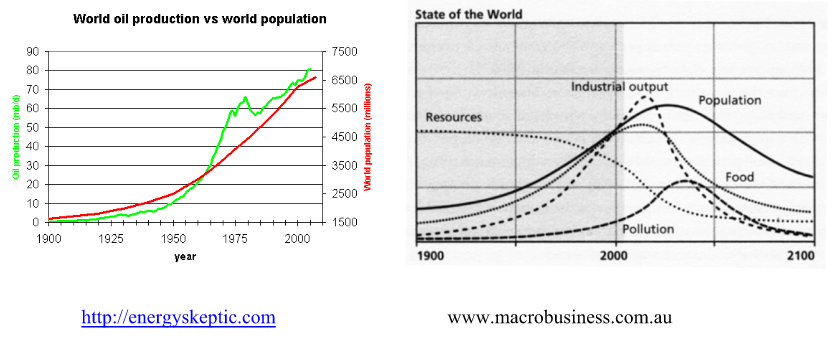

Over-harvesting Ocean Fisheries
An international group of ecologists and economists in a 2009 U.N report warned
that the world will run out of seafood by 2048 if steep declines in marine species
continue at current rates. This is based on a four-year study of catch data and the
effects of fisheries collapses. Steve Palumbi from Stanford University in California
who served as one of the other scientists on the project, added: “Unless we
fundamentally change the way we manage all the ocean species together, as
working ecosystems, then this century is the last century of wild seafood.” This
position is supported by NOAH.
Right now over 75% of the ocean species we consume for food are in decline and
being harvested faster than they can reproduce. Additionally, 90% of our larger
fish such as tuna and swordfish have been removed from the food chain all
together. [41] Hundreds of millions of people globally rely on fish from the oceans as
their primary source of protein and when those fish are gone there will be nothing
to replace those essential nutrients.


